The Basilica of Santa Croce in Gerusalemme in Rome preserves a small artifact of great value to Catholic devotion: it is the Titulus Crucis, the tablet that according to tradition was affixed to Jesus’ cross as a sign of mockery, identifying him as the king of the Jews. The Gospels differ slightly in reporting the words of the inscription known to all, since any depiction of the crucified shows it at the top of the cross: according to the Synoptic Gospels, above the head Jesus had written “This is Jesus, the King of the Jews,” while according to the Gospel of John the inscription read “Jesus the Nazarene, the King of the Jews,” and above all it bore the humiliating honorific title in three languages (“Many Jews,” we read in John 19:20, “read this inscription, because the place where Jesus was crucified was near the city; it was written in Hebrew, Latin and Greek.”). The Titulus Crucis of Holy Cross in Jerusalem bears exactly the inscription indicated by John’s Gospel in the three languages. However, one doubt must be dispelled immediately: the relic preserved in the Roman basilica is not an object from the time of Jesus Christ, but it is a medieval artifact. In 2002 it was in fact subjected to carbon 14 analysis to establish the age of the walnut wood on which the inscription is inscribed, and the examinations indicated a date to the 10th-11th centuries AD: the Titulus is therefore a medieval forgery, but it is not known whether it is a forgery tout court or, as some scholars have proposed, a possible copy of the lost original.
Renaissance men, however, could not have known for sure that it was an object produced a thousand years after Jesus’ crucifixion, and consequently the news of its discovery was greeted with great fanfare. It was Jan. 27, 1492, when workers at work in the basilica of Santa Croce in Gerusalemme, which was undergoing major renovations at the time, discovered, behind a brick, a lead casket, closed by three wax seals, and on which was written Ecce lignum crucis, “Behold the wood of the cross.” Inside the casket was the Titulus Crucis. The first to report the news of the discovery of the “arcula plumbea” that preserved the Titulus Crucis was a chronicler of the time, Leonardo di Sar zana (or Leonardo Sarzanese), who a few days later, on February 4, wrote a letter in Latin to a learned correspondent of his, Jacopo Gherardi known as “il Volaterrano” (the missive is preserved in the Vatican Library, in a codex, the Vatican Codex 3912, which collects a number of letters sent to Volaterrano): “there is no doubt, reverend father,” the letter reads, “that this piece of wood is a part of that most sacred wood on which our Savior was hung, fixed with nails, and are truly the titles of his gallows, of which the evangelists testify.”
The tablet was found inside the triumphal arch of the basilica, above the high altar (“in arcu eminentioris partis desuper altare maius,” reports Leonardo di Sarzana), and bore the inscription, fragmentary, at the top in Hebrew (which is only partially legible), in the middle in Greek and in the third line in Latin: the last two inscriptions are better readable, although, curiously, they are written from right to left. In the letter following Volaterrano, Leonardo di Sarzana stated that he had informed the lord of Florence, Lorenzo the Magnificent, of the find, and about a month later the then master of papal ceremonies, Johannes Burckhard, noted in his diary that he had deciphered the inscription that appeared on the three seals that closed the casket, and which bore the name “Gerardus cardinalis Sancte Crucis,” to be identified with the Bolognese cardinal Gerardus Caccianemici, who in 1124 was cardinal with the title of Santa Croce in Gerusalemme and in 1144 became pope with the name Lucius II. The reasons why the then cardinal allegedly sealed the Titulus Crucis in a casket by hiding it in a cavity of the basilica are not known: no record is preserved of the circumstances that led to the Titulus being placed in the casket, nor are there any records of its presence in Rome prior to Leonardo di Sarzana’s letter. Tradition believed that the Titulus had been found, along with the entire cross of Christ, by St. Helena, the mother of Emperor Constantine, in the fourth century, and that at some point in history it had left Jerusalem to arrive in Rome (since, after the sixth century, there are no more records of pilgrims describing it in accounts of their travels to the Holy Land). But, as mentioned, there are no documents before 1492.
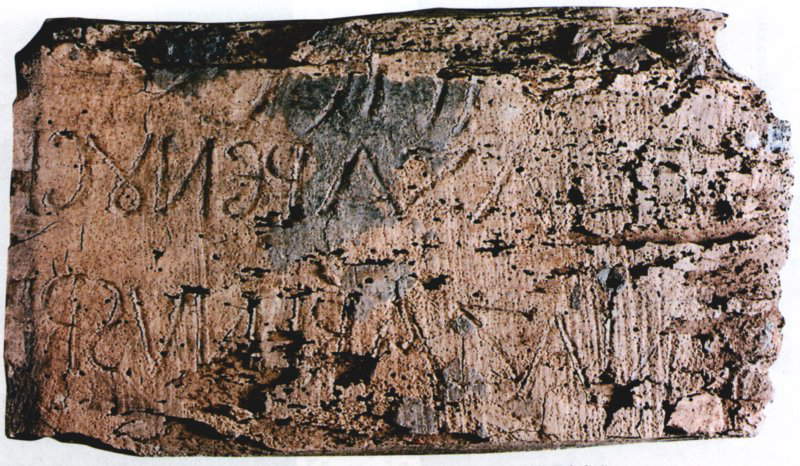 |
| Titulus Crucis (10th-11th century; wood, 25 x 14 x 4 cm; Rome, Santa Croce in Gerusalemme) |
 |
| The basilica of Santa Croce in Gerusalemme. Ph. Credit |
The news of the find had important repercussions forart as well. Of course, all the artists who had painted or sculpted the crucifix had not failed to decorate the vertical arm of the cross with the inscription quoted from the Gospels, but from 1492 painters and sculptors were able to confront what was believed to be the true title of the cross and thus produce works that could be considered more veracious, without inventing from scratch the iconography of the Titulus Crucis, which prior to 1492 was mostly reported with Latin inscriptions that traced the words of the Gospels or, as is known, with the abbreviation “INRI”(Iesus Nazarenus Rex Iudaeorum, “Jesus the Nazarene King of the Jews”). However, there had been no shortage of artists who had followed the Gospel of John by producing a trilingual cartouche: this is the case, for example, with Giotto’s Crucifix in Santa Maria Novella, or with Beato Angelico (Giovanni da Fiesole, born Guido di Pietro; Vicchio, c. 1395 - Rome, 1455), who included it in the Crucifixion with Saints frescoed in the ancient chapter house of the convent of San Marco in Florence. But who was the first artist to create a work with the “true” title of the cross? We do not know for sure because the chronology is disputed as these works are very close in time and of uncertain dating, but the circle is narrowed around two artists who were working in Florence at the time of the find: Luca Signorelli (Cortona, c. 1450 - 1523) and Michelangelo Buonarroti (Caprese, 1475 - Rome, 1564).
Michelangelo was a very promising 18-year-old who frequented Lorenzo the Magnificent and was one of the young talents who practiced in the Garden of San Marco: after the death of his powerful patron, the artist moved for some time to the convent of Santo Spirito in Florence, where he went on the recommendation of the Medici and where he was the guest of the prior, Niccolò di Lapo Bichiellini, who allowed him to continue his studies of anatomy by examining the bodies of those who died in the convent’s hospital. Michelangelo, “to please the prior,” that is, to thank him for his hospitality, sculpted for him the crucifix that today adorns the sacristy erected by the Magnifico himself. The wooden crucifix dates to around 1493 and is believed to be the first work bearing the Titulus Crucis after it was found, complete with Greek and Latin inscriptions reversed. “Whoever drew the inscription of the sign found in Santo Spirito,” Parronchi wrote back in the 1960s, "could not have done so if he did not know the Titulus Crucis found in Santa Croce in Gerusalemme. And it seems to me that this is already enough to allow us to suppose that the inscription of the relic, known and appreciated in Lorenzo’s circle, was kept well in mind by Michelangelo when, a year or so after the death of the Magnifico, having completed the perfect anatomical study of his Crucifix, he donated it, provided with the cross and the sign, to the prior of Santo Spirito Niccolò Bicchiellini." Reconnaissance and authentication of the Titulus Crucis came later (in particular, it was not until 1496 that Pope Alexander VI authenticated the relic as a real fragment of the cross on which Jesus had been nailed), but for the artists it was not a problem: “it was,” Parronchi goes on to explain, “a graphic figuration of it, not an object of worship as such, and it is therefore explicable that, even on a level of artistic representation, they preferred to reproduce what was believed to be the true inscription.” For the sake of completeness, however, it will be appropriate to note that although Parronchi agreed with Michelangelo’s authorship of the cartouche on the crucifix of Santo Spirito, he believed, on mainly stylistic grounds, that the real crucifix made by Michelangelo for the prior was the one now preserved in the Oratory of San Rocco in Massa, a work of fine quality but little studied, whose authorship is still under discussion and where a Titulus Crucis similar to that of the Crucifix of Santo Spirito is noted.
The young Michelangelo may, however, have been preceded by Signorelli, who inserts the Titulus Crucis with the trilingual inscription in two works, the Crucifixion in the Uffizi and the Stendardo dello Spirito Santo preserved in the Galleria Nazionale delle Marche in Urbino. Starting with the latter work, it is a canvas dating back to 1494: we know this because the notarial deed, dated June 1494, in which a majolica painter, Filippo Gueroli, mediates between the painter and the confraternity of the Holy Spirit of Urbino in the contract in which the sodality commissioned the work from the Cortona artist was found. The banner was to show on one side the scene with the Descent of the Holy Spirit and, on the other, the Crucifixion: the artist executed the work on time, but it was separated into its two parts probably during the 18th century. What Signorelli inserts in his Crucifixion is an almost perfect reproduction of the Titulus Crucis found in Rome (contrary, therefore, to what Michelangelo had done, who in the Crucifix of Santo Spirito had freely interpreted the title): the inscription in Greek replicates exactly that of the Titulus, while the inscription in Hebrew was reconstructed since in the walnut wood discovered in Santa Croce in Gerusalemme it was almost illegible, and the same goes for the one in Latin, which follows the Titulus up to a certain point, and then is also made the subject of a hypothetical reconstruction. The legible parts (including the Greek inscription, which also breaks off in the Titulus but which, curiously, Signorelli does not integrate) are, however, reproduced slavishly. It is therefore clear that Signorelli was very familiar with the Titulus Crucis: the painter from Cortona stayed in Rome several times during his career, but never in the period between the discovery of the relic and the making of the painting. So it is clear that a drawing reproducing the Titulus Crucis circulated in Florence: a scholar who lived in the first half of the nineteenth century, Leandro de Corrieris, reports in one of his books in 1830 that it was Leonardo di Sarzana himself who sent Lorenzo the Magnificent an illustration of the Titulus Crucis. This may have been the drawing seen by Signorelli and Michelangelo.
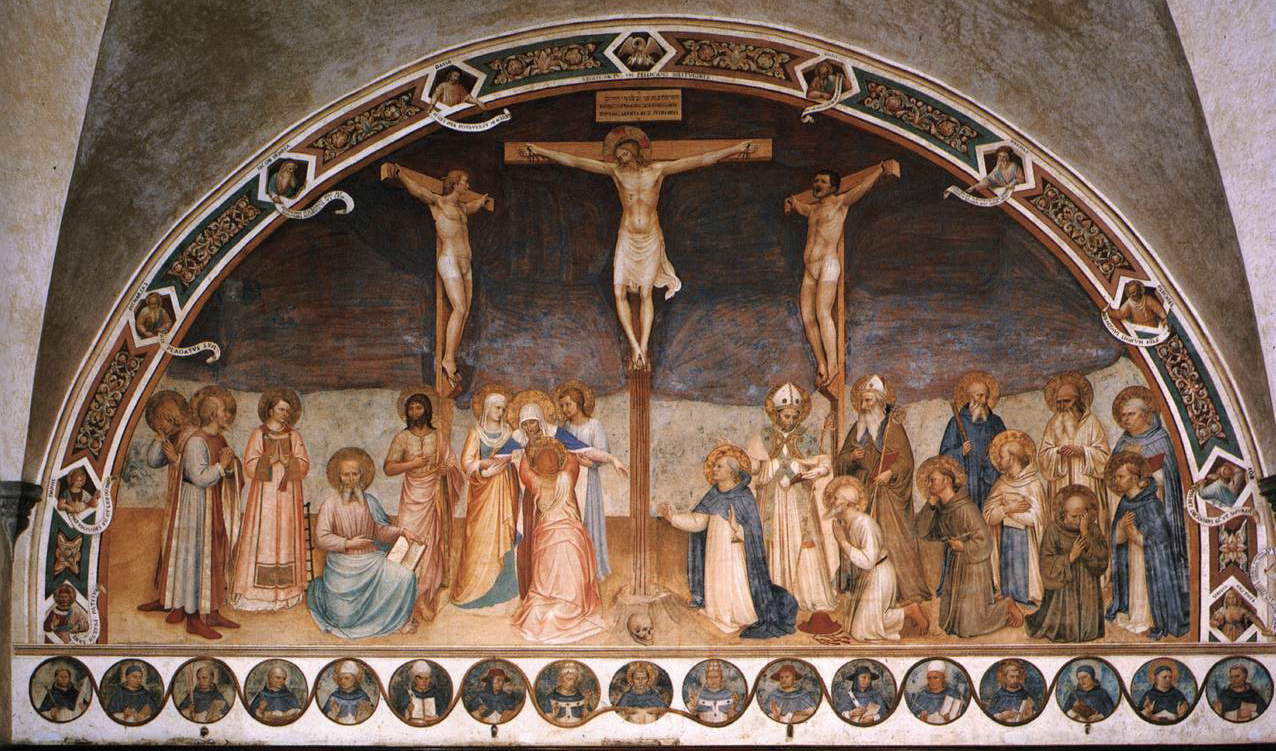 |
| Beato Angelico, Crucifixion with Saints (1441-1442; fresco, 550 x 950 cm; Florence, Museo Nazionale di San Marco) |
 |
| The Titulus Crucis in Beato Angelico’s Crucifixion with Sa ints |
 |
| Michelangelo, Crucifixion of Santo Spirito (c. 1493; polychrome wood, 139 x 135 cm; Florence, Santo Spirito). Ph. Credit Francesco Bini |
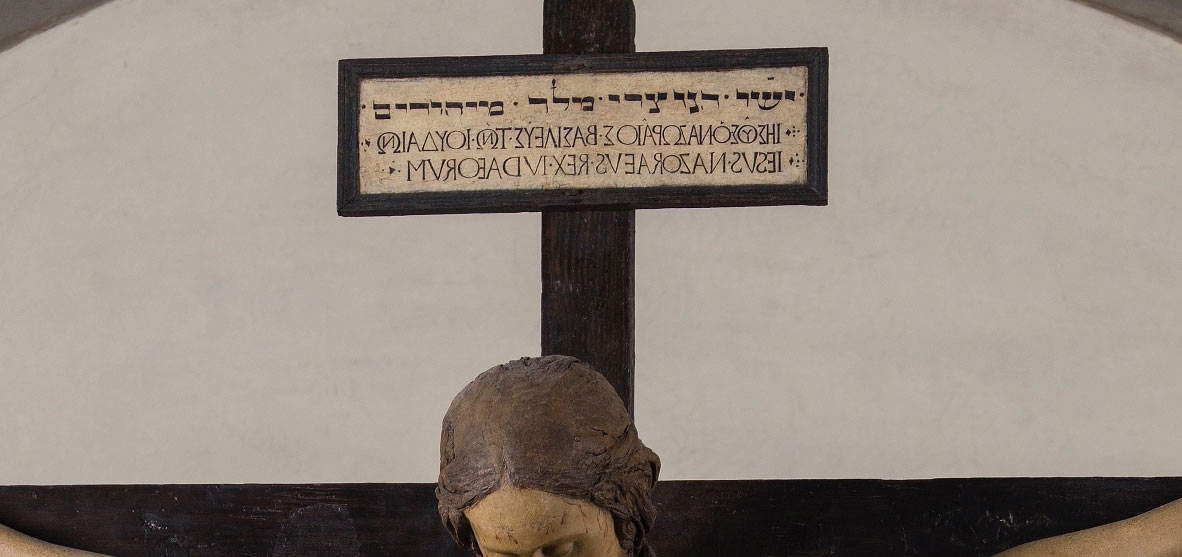 |
| The Titulus Crucis on the Crucifix of Santo Spirito |
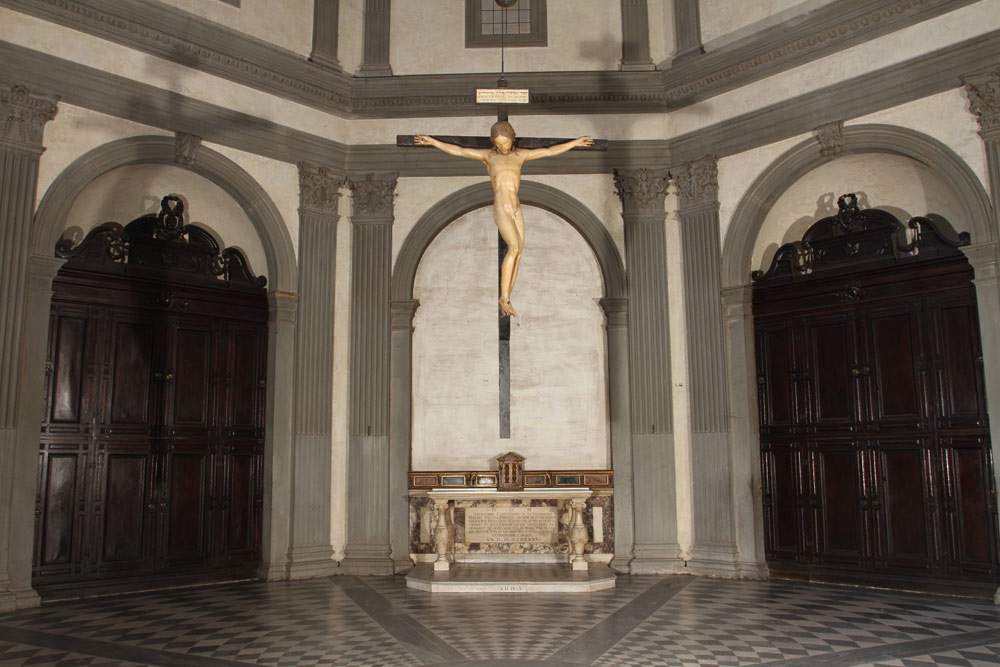 |
| The Crucifix in the Sacristy of Santo Spirito |
 |
| Michelangelo?, Crucifix (late 15th-16th century; wood; Massa, Oratory of San Rocco). Ph. Credit Gianluca Matelli |
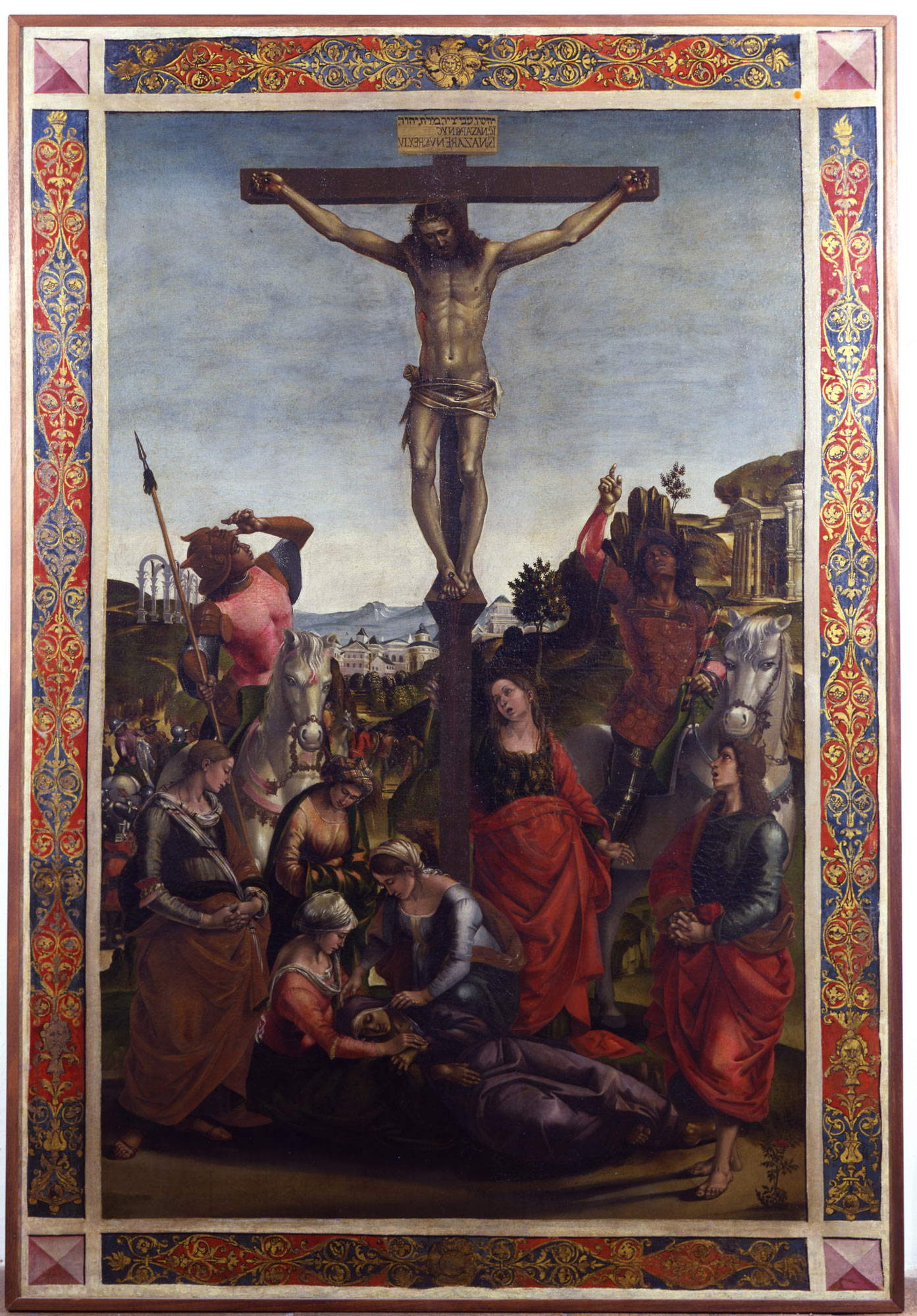 |
| Luca Signorelli, Crucifixion (1494; oil on canvas, 156 x 104 cm; Urbino, Galleria Nazionale delle Marche) |
 |
| The Titulus Crucis in the Standard of the Holy Spirit |
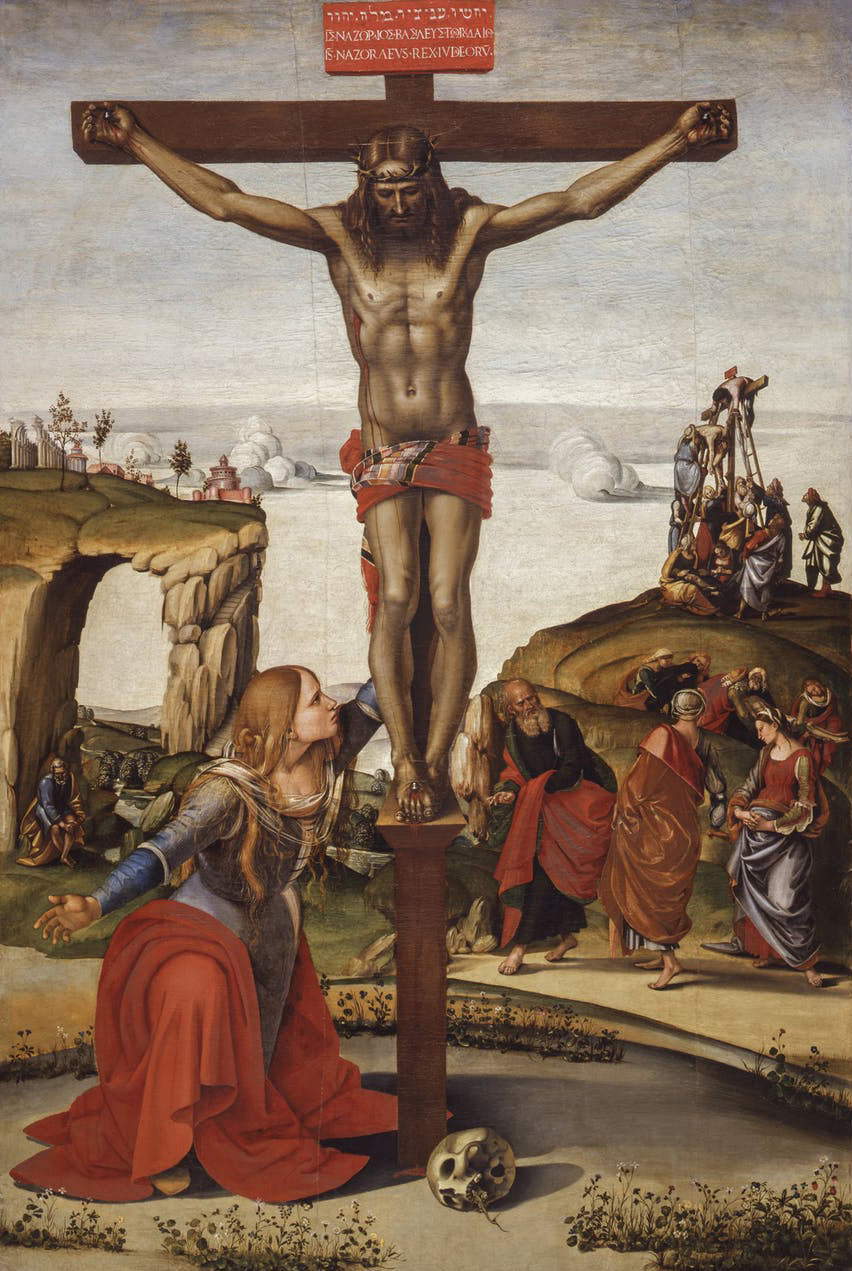 |
| Luca Signorelli, Crucifixion with Magdalene, also known as Crucifixion of Annalena (c. 1490-1498; oil on canvas, 249 x 166 cm; Florence, Uffizi Gallery) |
It is not, however, the Urbino banner that contends for primacy with Michelangelo, but rather the Uffizi Crucifixion, also known as the Annalena Crucifixion because it came from the convent of San Vincenzo d’Annalena in Florence. Here, the Titulus Crucis is not as faithful as the one that appears in the Urbino canvas (the inscriptions, moreover, are legible from left to right), but the cartouche could still assume knowledge of the fragment found in Rome in 1492. A wide variety of dates have been proposed for this painting: one hypothesis wants the work commissioned directly by Annalena Malatesta, daughter of Galeotto Malatesta, lord of Rimini, and foundress of the monastery in the 1450s, several years after the death of her husband Baldaccio d’Anghiari, who was barbarously murdered in Palazzo Vecchio in 1441 as part of a clash between political factions, and retired as a Dominican tertiary to her own house (which became the first nucleus of the monastery) following the disappearance of her son Galeotto. Annalena Malatesta passed away at the age of seventy-two in 1491, and would therefore have been in time to commission the canvas from Signorelli, probably around 1490. According to another hypothesis, formulated by scholar Laurence B. Kanter, the work would perhaps have been commissioned directly by Lorenzo the Magnificent: probably, Kanter speculates, to commemorate Annalena Malatesta who had just passed away. Both hypotheses would thus be compatible with a dating to 1490-1492. Others, on the other hand, have proposed, on stylistic grounds, to extend its dating to around 1498, since the painting is comparable to other works that Signorelli produced at the end of the century (the Uffizi Gallery itself affixes the chronology 1490-1498 to the work).
Whether the first was Michelangelo or Signorelli, however, it can be noted that, beginning with the discovery of the Titulus Crucis, the practice of hanging the tablet with the trilingual inscription on the crosses (carved or painted) became more widespread (even in later centuries: the most famous work in this regard is probably Diego Velázquez’s Crucifix, and Rubens even, instead of a tablet, hung a sheet of paper from his very famous Crucifix in the Koninklijk Museum voor Schone Kunsten in Antwerp): however, there was no shortage of artists who opted for the traditional acrostic (again, to stay with the seventeenth century, the best-known crucifixes are those of Guido Reni, who remained faithful to the abbreviation “INRI”). But interestingly, the enthusiasm for that 1492 discovery was immediately reflected in the works of contemporary artists.
Reference bibliography
Warning: the translation into English of the original Italian article was created using automatic tools. We undertake to review all articles, but we do not guarantee the total absence of inaccuracies in the translation due to the program. You can find the original by clicking on the ITA button. If you find any mistake,please contact us.